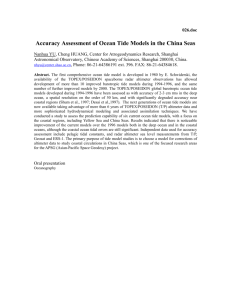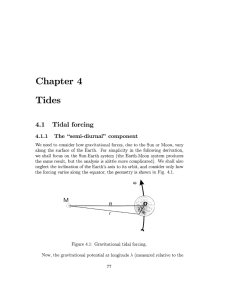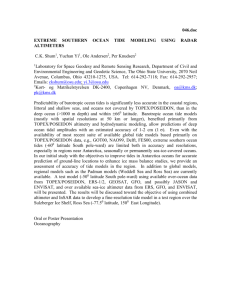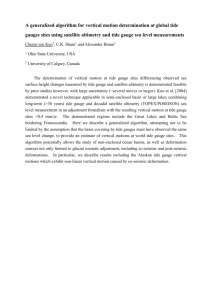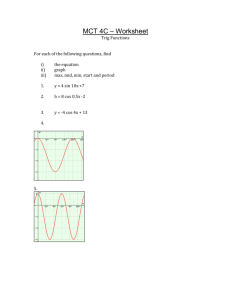1
advertisement
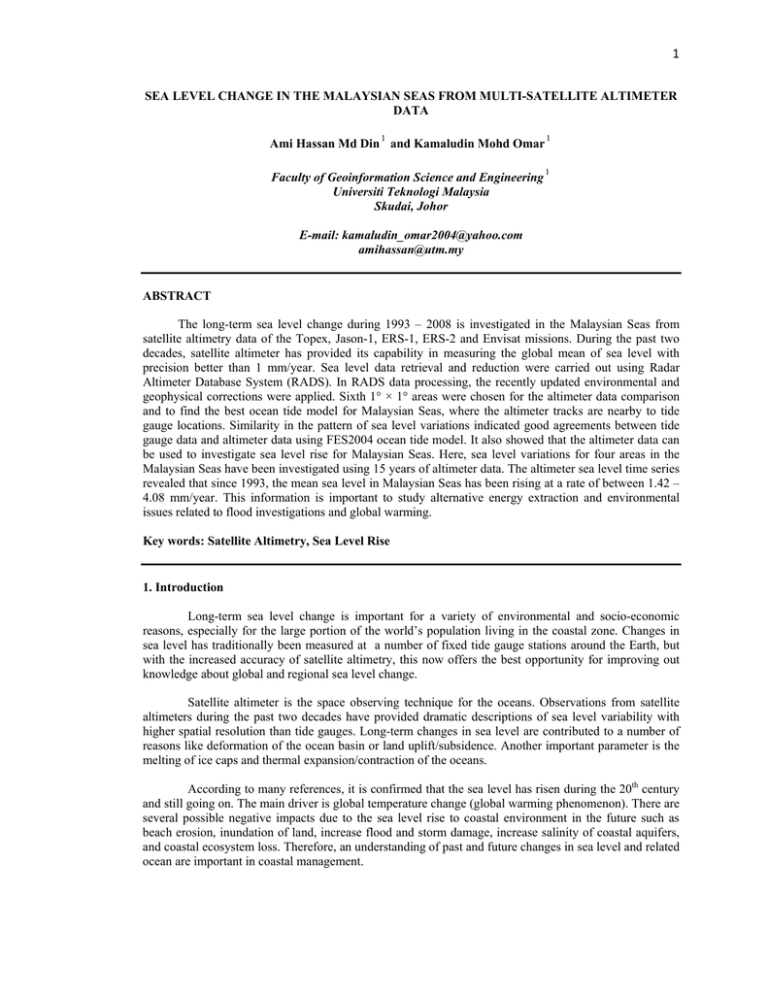
1 SEA LEVEL CHANGE IN THE MALAYSIAN SEAS FROM MULTI-SATELLITE ALTIMETER DATA Ami Hassan Md Din and Kamaludin Mohd Omar 1 1 Faculty of Geoinformation Science and Engineering Universiti Teknologi Malaysia Skudai, Johor 1 E-mail: kamaludin_omar2004@yahoo.com amihassan@utm.my ABSTRACT The long-term sea level change during 1993 – 2008 is investigated in the Malaysian Seas from satellite altimetry data of the Topex, Jason-1, ERS-1, ERS-2 and Envisat missions. During the past two decades, satellite altimeter has provided its capability in measuring the global mean of sea level with precision better than 1 mm/year. Sea level data retrieval and reduction were carried out using Radar Altimeter Database System (RADS). In RADS data processing, the recently updated environmental and geophysical corrections were applied. Sixth 1° × 1° areas were chosen for the altimeter data comparison and to find the best ocean tide model for Malaysian Seas, where the altimeter tracks are nearby to tide gauge locations. Similarity in the pattern of sea level variations indicated good agreements between tide gauge data and altimeter data using FES2004 ocean tide model. It also showed that the altimeter data can be used to investigate sea level rise for Malaysian Seas. Here, sea level variations for four areas in the Malaysian Seas have been investigated using 15 years of altimeter data. The altimeter sea level time series revealed that since 1993, the mean sea level in Malaysian Seas has been rising at a rate of between 1.42 – 4.08 mm/year. This information is important to study alternative energy extraction and environmental issues related to flood investigations and global warming. Key words: Satellite Altimetry, Sea Level Rise 1. Introduction Long-term sea level change is important for a variety of environmental and socio-economic reasons, especially for the large portion of the world’s population living in the coastal zone. Changes in sea level has traditionally been measured at a number of fixed tide gauge stations around the Earth, but with the increased accuracy of satellite altimetry, this now offers the best opportunity for improving out knowledge about global and regional sea level change. Satellite altimeter is the space observing technique for the oceans. Observations from satellite altimeters during the past two decades have provided dramatic descriptions of sea level variability with higher spatial resolution than tide gauges. Long-term changes in sea level are contributed to a number of reasons like deformation of the ocean basin or land uplift/subsidence. Another important parameter is the melting of ice caps and thermal expansion/contraction of the oceans. According to many references, it is confirmed that the sea level has risen during the 20th century and still going on. The main driver is global temperature change (global warming phenomenon). There are several possible negative impacts due to the sea level rise to coastal environment in the future such as beach erosion, inundation of land, increase flood and storm damage, increase salinity of coastal aquifers, and coastal ecosystem loss. Therefore, an understanding of past and future changes in sea level and related ocean are important in coastal management. 2 Naeije et al. (2008) from Delft had studied evolution of almost 17 years sea level change combining all altimeter data in RADS (leaving out Geosat and Poseidon). The study came out with the analysis of the global mean sea level rise at the rate of 2.53mm/year. In addition, Omar et al. (2006) said over the past few decades, satellite altimetry demonstrated its capability in measuring temporal change of the global mean sea level with precision better than 1 mm/year. Sea level trends were estimated from 1.5 to 8.9 mm/year using two decades of tide gauges observations along coastal of Malaysia. Comparison of 1o x 1o areas at the tide gauge locations nearby Topex track clearly showed good agreement in pattern and trend of sea level variations. 2. Multi-mission Altimeter and Data Processing Satellite altimeter measurements have now been continuously available since 1991, through the ERS1, TOPEX/Poseidon, ERS2, Geosat Follow-on, Jason and ENVISAT missions. Measurements from these instruments have revolutionized our knowledge of the ocean, through studies in sea level, ocean circulation and climate variability. In 1992 TOPEX/Poseidon satellite altimetry mission was launched and its mission was ended in 2002. Since then it was replaced by Jason-1. Both satellite missions provide the most precise altimetry data when compared to others. Although satellite altimetry records are still quite short compared to the tide gauge data sets, this technique appears quite promising for sea level change problem because it provides sea level measurement with large coverage. A precision of about 1 mm/year of measurement global change can be obtained. Meanwhile, ERS launched and operated by the European Space Agency, the ERS satellites are the first missions acquiring commercially available microwave radar data, offering new opportunities for all-weather remote sensing applications. Both ERS satellites were launched into a sun-synchronous orbit at an inclination of 98° 52’ and an altitude between 782 and 785 km. In March 2002, the European Space Agency launched The Environmental Satellite (Envisat), an advanced polar-orbiting Earth observation satellite which provides measurements of the atmosphere, ocean, land, and ice. This satellite mission is the successor to the European Space Agency (ESA) Remote Sensing Satellites ERS-1 and ERS-2. Generally, radar altimetry is among the simplest of remote sensing techniques. Two basic geometric measurements are involved. Firstly, the distance between the satellite and the sea surface is determined from the round-trip travel time of microwave pulses emitted downward by the satellite’s radar and reflected back from the ocean. Secondly, independent tracking systems are used to compute the satellite’s three-dimensional position relative to a fixed Earth coordinate system. Combining these two measurements yields profiles of sea surface topography, or sea level, with respect to the reference ellipsoid (a smooth geometric surface which approximates the shape of the Earth). Figure 1 shows the principle of satellite altimetry. h=H–R hd = h – hg – hT – ha Where, H = satellite altitude R = range measurement h = sea surface height (SSH) hg = geoid/mss height hT = ocean tide height ha = atmospheric effect 3 Figure 1: Principle of satellite altimetry (Source: NASA website, 2009) In this study, sea level data retrieval and reduction were carried out using Radar Altimeter Database System (RADS). In RADS data processing, the recently updated environmental and geophysical corrections were applied. The sea level data have been corrected for orbital altitude, altimeter range corrected for instrument, sea state bias, ionospheric delay, dry and wet tropospheric corrections, solid earth and ocean tides, ocean tide loading, pole tide, electromagnetic bias and inverse barometer correction. The corrections were done by applying specific models for each satellite altimetry missions in RADS. The corrections are summarized in Table 1 below: Table 1: Corrections applied for sea level data extraction in RADS Correction TOPEX Jason-1 ERS-1 ERS-2 Envisat Orbit GGM02C gravity (ITRF2000) EIGEN CG03C gravity DGM-E04 gravity DGM-E04 gravity EIGEN CG03C gravity Dry Troposphere ECMWF ECMWF ECMWF ECMWF ECMWF Wet Troposphere Radiometer Measurement Radiometer Measurement Radiometer Measurement Radiometer Measurement Radiometer Measurement Ionosphere Smoothed dualfreq value Smoothed dual-freq value NIC08 NIC08 Smoothed dual-freq value Inverse Barometer MOG2D MOG2D MOG2D MOG2D MOG2D Solid Tide Applied Applied Applied Applied Applied Ocean Tide FES2004/ GOT00.2/ No Ocean Tide FES2004/ GOT00.2/ No Ocean Tide FES2004/ GOT00.2/ No Ocean Tide FES2004/ GOT00.2/ No Ocean Tide FES2004/ GOT00.2/ No Ocean Tide Load Tide FES2004/ GOT00.2/ No Load Tide FES2004/ GOT00.2/ No Load Tide FES2004/ GOT00.2/ No Load Tide FES2004/ GOT00.2/ No Load Tide FES2004/ GOT00.2/ No Load Tide Pole Tide Applied Applied Applied Applied Applied Sea State Bias BM3/BM4 BM3/BM4 BM3/BM4 BM3/BM4 BM3/BM4 Geoid/Mass Height CLS01 MSS CLS01 MSS CLS01 oMSS CLS01 MSS CLS01 MSS Furthermore, because of factors such as orbit error and inconsistency in the satellite orbit frame, the sea surface heights (SSH) from different satellite missions need to be adjusted to a ‘standard’ surface. In this research, the SSH from the Topex mission have served as a standard surface in the stage of integrated data processing because of its highly accurate orbit. That is called as crossover adjustment for dual-satellite missions. 4 3. Local Mean Sea Level (MSL) Observed by Tide Gauges In Malaysia, there are 12 tidal stations along the coast of Peninsular Malaysia (West Malaysia) and 9 tidal stations along the coast of Sabah and Sarawak (East Malaysia). These tidal stations networks have been operational since 1984 along the coastal areas of Malaysia. The main objective of this continuous observation network is to enable continuous time series of sea level heights to be obtained for the purpose of establishing a vertical datum for the nation. Figure 2, 3 and 4 show the plot of monthly sea levels for tide gauge stations in Malaysia. Figure 2: Monthly mean sea levels for tide gauge stations in West Coast Peninsular Malaysia Figure 3: Monthly mean sea levels for tide gauge stations in East Coast Peninsular Malaysia Figure 4: Monthly mean sea levels for tide gauge stations in Sabah & Sarawak 5 The trend rates for tide gauge stations in Malaysia are given in Table 2. It shows that trends do exist in the sea level height around Malaysia and varies quite significantly from one location to another. Furthermore, the linear trends of the Mean Sea Level (MSL) variations are positive, indicating an overall rise in the sea level around the coast of Malaysia. Table 2: Sea Level Rise of Malaysia at Tide Gauges (DSMM, 2008) The rising trend ranges from 1.21 mm/year at P. Langkawi and 3.02 mm/year at Kukup on the west coast peninsular. Taking the average of the west coast peninsular group, it shows that the relative sea level trend in this group is about 2.02 mm/year. Meanwhile, for the east coast peninsular, the rising trend ranges from 1.73 mm/year at Geting and 3.20 mm/year at Chendering. The average of sea level trends at east coast peninsular is approximate 2.35 mm/year. In Sabah and Sarawak, the rate of sea level trend in this group was calculated without including Lahad Datu, Kudat and Labuan stations. The rates of those locations are incorrect due to non-continuous and short period of available data. The rising trend of this group ranges from 0.12 mm/ year at Bintulu and 3.45 mm/year at Sandakan. The average of the sea level trend in this group is estimated at 2.24 mm / year. Taking the combination of the sea level trend of three groups, it indicates that the trend for Malaysian Seas is about 2.2 mm/year using tide gauges data. 4. Altimeter Data Extraction using Different Ocean Tides Model In this research, satellite altimeter data was processed by using ocean tide models such as GOT00.2, FES2004 and without ocean tide models. These actions were taken to find the best ocean tide model for Malaysian Seas. Sixth areas were chosen near to the tide gauges stations. Combinations of Topex and Jason1 satellites were used to extract sea level data from RADS. These satellites were chosen because they give more accurate data compare with other satellites. Table 3 shows the result of the sea level trend for Topex and Jason1 data extraction using different ocean tide models for selected areas near to the tide gauges stations. 6 Table 3: Sea level trend using different ocean tide model Refer to Table 3, the linear trends of the sea level variations using different ocean tide models are positive, indicating an overall rise in the sea level for Malaysian Seas. The rising trend ranges from 1.54 mm/year at P. Langkawi and 3.34mm/year at Sandakan when applying FES2004 ocean tide model. The GOT00.2 ocean tide result shows that the sea level trend ranges from 1.87 mm/year at P. Langkawi and 3.99 mm/year at P. Tioman. Meanwhile, the sea level trends are incorrect and no pattern when extracting altimeter data without using ocean tide model. 5. Comparison between Altimetry and Tide Gauge Station This section discusses the comparison of different ocean tide models using satellite altimeter and tide gauge data, it is to find the best ocean tide model for Malaysian Seas. Then, the data was used to validate the results from combination of Topex and Jason1 data. Sixth 1° × 1° areas were chosen for the comparison, where the altimeter tracks were nearby to tide gauge locations (Figure 5). The result of the comparison between the different ocean tide models using satellite altimeter and tide gauge data are presented in Figure 6 and Figure 7. Figure 5: Selected 1° × 1° areas nearby to tide gauge stations Table 4 shows the variation of sea level obtained from altimeter using different ocean tide models and tide gauges in K. Kinabalu, Tawau, Sandakan, Geting, P. Tioman and P. Langkawi. Similarity in the pattern of sea level variations indicated good agreements between tide gauge data, FES2004 and GOT00.2 model. However, the result of altimeter data extraction without using ocean tide models shows the differences between Topex/Jason1 and tide gauge data. It also shows no good pattern between altimeter data extraction without using the ocean tide model and tide gauge data. 7 Table 4: Sea Level Rise from tide gauge and altimeter Linear trend for Topex/Jason1 (Altimeter) and tide gauge measurements were evaluated over the same period at each area in order to produce comparable results. Refer to Table 5, it indicated that the differences of linear trend between tide gauge and FES2004 model (Altimeter data) were considered small, within -0.33 to 0.11 mm/ year. Meanwhile, the differences of the sea level trend between tide gauge and GOT00.2 model were shown bigger than the differences between tide gauge and FES2004 model. Table 6 shows that the differences of linear trend between tide gauges and GOT00.2 model were within -0.66 to 1.11 mm/year. However, the linear trend of altimeter data without applying ocean tide model was incorrect and no pattern. The results showed that the comparison of linear trend between tide gauge and no ocean tide model (altimeter data) were quite big differences, range from – 5.29 to 1.10 mm/year (Table 7). Table 5: Comparison of sea level trend between tide gauge and FES2004 model Table 6: Comparison of sea level trend between tide gauge and GOT00.2 model Figure 6: Plot of Sea Level Rise at Kota Kinabalu, Tawau and Sandakan from tide gauge and altimeter dat 8 Figure 7: Plot of Sea Level Rise at P. Langkawi, P. Tioman and Geting from tide gauge and altimeter data 9 10 Table 7: Comparison of sea level trend between tide gauge and no ocean tide model These results basically encourage us to estimate the rate of sea level rise in Malaysian Seas using FES2004 ocean tide model. It also shows that the altimeter data can be used to investigate sea level rise for Malaysian Seas due to the small differences of linear trend between altimeter and tide gauge data, within -0.33 to 0.11 mm/ year (Figure 8). Figure 8: Tide gauge and altimeter data differences 6. Sea Level Trend using Multi-satellite Altimetry As mentioned above, it is well known that satellite altimeter is able to provide sea level observations with higher spatial resolution than the tide gauge. Five satellite altimeter missions have been used in this study. Topex altimetry data (NASA/CNES Agency) were analyzed in Malaysian Seas from January 1993 to July 2002 (cycle 11 – cycle 363). Jason1 data ((NASA/CNES Agency) were considered from August 2002 to April 2008 (cycle 21- cycle 230). Meanwhile, ERS-1 altimetry data (ESA Agency) were taken from January 1993 to April 1995 (cycle 91 – cycle 145) and ERS-2 (ESA Agency) were analyzed from May 1995 to September 2002 (cycle 1 – cycle 78). Envisat altimetry data (ESA Agency) were taken from October 2002 to April 2008 (cycle 10 – cycle 67). These satellites missions were divided into two tracks in doing sea level rise analysis. First track was the combination of Topex and Jason1 altimetry missions. The other track was the combination of ERS-1, ERS-2 and Envisat altimetry missions. This action was taken because they were same orbits and characteristics. For each of the satellite missions the average over each cycle and over the entire Malaysian Seas of the corrected sea surface heights (SSH) above mean sea surface model CLS01 MSS was computed and a simple regression model was fitted to the results. Four study areas were selected to investigate the sea level variation of Malaysian Seas: South China Sea, Malacca Strait, Sulu Sea and Celebes Sea. Finite Element Solution (FES2004) model was employed in the process of data reduction. The time series of mean sea level were derived from the averages of monthly altimeter data. The sea level time series of South China Sea and Malacca Strait using multi-mission altimetry are presented in Figure 9 to Figure 10. 11 Both South China Sea and Malacca Strait depicted that the rise of Mean Sea Level was clearly visible from altimeter. The rate of sea level rise obtained from Topex/Jason1 in South China Sea was about 1.99 mm/year. Sea level trend of South China Sea from the combination of ERS1, ERS2 and Envisat estimated a different rate, which was 1.30 mm/year. However, sea level time series of South China Sea using five satellites combination was about 1.64 mm/year. Figure 9 shows that the short-term periodic circulation of mean sea level was revealed at the open South China Sea. Figure 10 summarized the results of Mean Sea Level variation computations for Malacca Strait using multi-mission altimetry measurement. Using the straight line fitting, the sea level rise for Malacca Strait using Topex/Jason1, ERS1/ERS2/Envisat and All satellites combination were estimated at 1.37, 1.37 and 1.42 mm/year respectively. However, Figure 10 indicated that the tide model applied does not fit very well in the shallow Malacca Strait where the short term ocean circulation seems to be rather noisy. This is due to the fact that Malacca Strait is narrow and shallow water. Meanwhile, Mean Sea Level variations for Sulu Sea and Celebes Sea were presented in Figure 11 to Figure 12. The figures show that both areas have similar pattern of sea level variations and tide model seems to fit well to these areas. The effect of El-Nino on sea level was clearly visible where the sea level begins to fall in 1997 and back to normal in the middle of 1998. Increasing of sea level trend in these both areas were more higher compared with South China Sea and Malacca Straits. Figure 11 depicted that the rate of sea level rise for Sulu Sea using Topex/Jason1, ERS1/ERS2/Envisat and All satellites combination were given at 3.88, 3.63 and 3.76 mm/year respectively. Meanwhile, Figure 12 presented that using straight line fitting, sea level rise for Celebes Sea using Topex/Jason1, ERS1/ERS2/Envisat and All satellites combination were estimated at 3.96, 4.21 and 4.08 mm/year respectively. All figures indicated that the close similarity of the time series of all altimeters was very encouraging. Sea level trend can also be analyzed by using map of two-dimensional data distribution. Figure 13, Figure 15, Figure 17 and Figure 19 show the resulting distribution of the sea level trend for study areas covering Malaysian Seas, determined over the period January 1993 to July 2002 by TOPEX and May 1995 to September 2002 by ERS-2. Green colours (indicating rising sea levels) dominate, but purple colours (indicating dropping sea levels) were prevalent as well. Most features were presented in both independently determined maps. Some features were clearly transient and were expected to disappear or at least diminish in magnitude over time. To verify whether the presence of transient features was reduced, the length of the time series was increased over the data from various altimeters. By combining TOPEX and Jason-1 data on the one hand and ERS-1, ERS-2 and Envisat on the other, two independent maps of sea level trends can be determined for the period of January 1993 to April 2008 (Figure 14, Figure 16, Figure 18 and Figure 20). Thus, compared to Figure 13, Figure 15, Figure 17 and Figure 19 transient features were much less prominent and also areas of negative trends have become smaller. The maps agree very closely on the sign, magnitude and distribution of sea level trends over Malaysian Seas. Figure 9: Plot of Sea Level Time Series of South China Sea. Top: Combination of TOPEX and Jason-1. Centre: Combination of ERS-1, ERS-2 and Envisat. Bottom: All Satellites Combination 12 Figure 10: Plot of Sea Level Time Series of Malacca Strait. Top: Combination of TOPEX and Jason-1. Centre: Combination of ERS-1, ERS-2 and Envisat. Bottom: All Satellites Combination 13 14 Figure 11: Plot of Sea Level Time Series of Sulu Sea. Top: Combination of TOPEX and Jason-1. Centre: Combination of ERS-1, ERS-2 and Envisat. Bottom: All Satellites Combination 15 Figure 12: Plot of Sea Level Time Series of Celebes Sea. Top: Combination of TOPEX and Jason-1. Centre: Combination of ERS-1, ERS-2 and Envisat. Bottom: All Satellites Combination 16 Figure 13: Sea level trend for South China Sea. Top: TOPEX (January 1993 to July 2002). Bottom: ERS2 (May 1995 to September 2002) Figure 14: Sea level trend for South China Sea estimates for the period January 1993 to April 2008. Top: Combination of TOPEX and Jason-1. Bottom: Combination of ERS-1, ERS-2 and Envisat Figure 15: Sea level trend for Malacca Strait. Left: TOPEX (January 1993 to July 2002). Right: ERS-2 (May 1995 to September 2002) Figure 16: Sea level trend for Malacca Strait estimates for the period January 1993 to April 2008. Left: Combination of TOPEX and Jason-1. Right: Combination of ERS-1, ERS-2 and Envisat 17 18 Figure 17: Sea level trend for Sulu Sea. Top: TOPEX (January 1993 to July 2002). Bottom: ERS-2 (May 1995 to September 2002) Figure 18: Sea level trend for Sulu Sea estimates for the period January 1993 to April 2008. Top: Combination of TOPEX and Jason-1. Bottom: Combination of ERS-1, ERS-2 and Envisat Figure 19: Sea level trend for Celebes Sea. Top: TOPEX (January 1993 to July 2002). Bottom: ERS-2 (May 1995 to September 2002) Figure 20: Sea level trend for Celebes Sea estimates for the period January 1993 to April 2008. Top: Combination of TOPEX and Jason-1. Bottom: Combination of ERS-1, ERS-2 and Envisat. 19 20 7. Conclusion The merging of multi-mission altimetry data increases the time series lengths and the spatial resolution of the data. The advantage is important for long term sea level change study, as the altimeter satellite lifetime is too short for long term, decadal and inter-annual studies. In this study altimetry data from different missions have been used over the same decade to investigate sea level rise for Malaysian Seas. Analysis of the trend rates for tide gauge stations in Malaysia is positive, indicating an overall rise in the sea level around the coast of Malaysia. Sea level trend has been rising at a rate of between 0.12 – 3.45 mm/year at tide gauge station in Malaysia. Besides, sixth 1° × 1° areas were chosen for the altimeter data validation and to find the best ocean tide model for Malaysian Seas, where the altimeter tracks are nearby to tide gauge locations. Linear trend for Topex/Jason1 (Altimeter) and tide gauge measurements were evaluated over the same period at each area in order to produce a comparable result. Similarity in the patterns of sea level variations indicated good agreements between tide gauge data and altimeter data using FES2004 ocean tide model. The differences of linear trend between tide gauge and FES2004 model (Altimeter data) were considered small, within -0.33 to 0.11 mm/ year. Thus, these results basically encourage us to estimate the rate of sea level rise in Malaysian Seas using FES2004 ocean tide model. It was also showing that the altimeter data can be used to investigate sea level rise for Malaysian Seas. Both South China Sea and Malacca Strait depicted that the rise of Mean Sea Level was clearly visible from altimeter. The rate of sea level rise obtained using five satellites combination was about 1.64 and 1.42 mm/year respectively. Based on the result, the short-term periodic circulation of mean sea level was revealed at the open South China Sea. However, tide model applied does not fit very well in the shallow Malacca Strait where the short term ocean circulation seems to be rather noisy. This is due to the fact that Malacca Strait is narrow and shallow water. Meanwhile, Mean Sea Level variations for Sulu Sea and Celebes Sea show that both areas have a similar pattern of sea level variations and the tide model seems to fit well to these areas. The effect of ElNino on the sea level was clearly visible where the sea level begins to fall in 1997 and back to normal in the middle of 1998. The Increase of the sea level trend in these both areas was higher compared with South China Sea and Sulu Sea areas. The rate of sea level rise obtained using five satellites combination was about 3.76 and 4.08 mm/year respectively at these areas. Therefore, the altimeter sea level time series revealed that since 1993, the mean sea level in Malaysian Seas has been rising at a rate of between 1.42 – 4.08 mm/year. This information is important to study alternative energy extraction and environmental issues related to flood investigations and global warming. 21 8. References Department of Survey and Mapping Malaysia (DSMM). Fu, L.L., Cazenave A., Altimetry and Earth Science, A Handbook of Techniques and Applications, vol. 69 of International Geophysics Series. Academic Press, London, 2001. Naeije, M., Schrama, E, and Scharroo, R. 2000. The Radar Altimeter Database System Project RADS. Delft Institute for Earth Oriented Space Research, Delft University of Technology, Kluyverweg 1, 2629 HS Delft, The Netherlands. Naeije, M., Scharroo, R., Doornbos, E., Schrama, E., Global Altimetry Sea Level Service: GLASS. NIVR/SRON GO project: GO 52320 DEO, 2008. NASA, Jet Propulsion Laboratory, California Institute of Technology. Retrieved July 02, 2009, from http://www.jpl.nasa.gov Omar, K., Ses, S., Naieje, M., and Mustafar, M.S. The Malaysian Seas : Variation of Sea Level Observed by Tide Gauges and Satellite Altimetry. 2006. Omar, K., Ses, S., Naieje, M., and Mustafar, M.S. Study of Sea level Variation of Exclusive Economic Zone of Malaysia. 2006.
